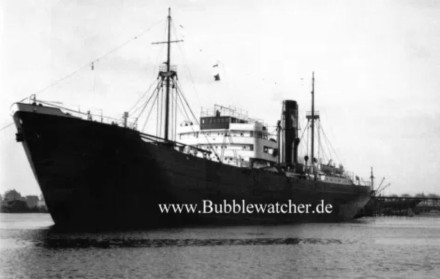History
The Brage was an ore carrier built by the Nordseewerke yard in Emden and launched in October 1937 for the Frigga shipping company.
On May 6th, 1940, during World War II, the vessel entered the Bay of Kiel with a cargo of iron ore from occupied Norway and struck a mine, which had been previously laid by an Allied airplane. The ship became unmaneuverable and started to sink. All crew members were saved before the ship went under.
As the 9000 tons of iron ore were essential for Nazi Germany's war economy, the cargo and the superstructure above the waterline were scrapped and salvaged during the war.
In the postwar period, the British occupying force agreed on concessions for further salvage operations, which also involved demolishing the hull with explosives under water and helmet divers to collect the scrap metal.
In recent times, wreck diver Peter Klink researched the history of the ship and wreck site and contacted the owner of a salvage company involved in the operation, who confirmed the identity of the wreck.
Description
Yard: Nordseewerke, Emden
The vessel was fitted with a compound steam engine (i.e. a double-expansion marine engine) and an exhaust steam turbine built by Rheinmetall AG in Berlin.

| Speed | 12 knots ~ 14 mph (22 km/h) |
|---|---|
| Length | 433 feet (132 m) |
| Beam | 59 feet (18 m) |
| Tonnage | 9300 ton |
Status
Not much of the wreck survived the salvage operations. It lies at a depth of 19 metres. Today the wreck is preserved up to a length of 40 metres, with both the bow and stern sections gone, and a preserved height of up to four metres. All engines, the deck, and superstructure has been salvaged. Only some frames and bulkheads are still discernible.
References
- Peter Klink (bubblewatcher.de).
Der Erzfrachter Brage. - Morgner, F. D. (1924).
Die Zwei- und Dreifachexpansionsmaschinen.
pp 85-90.
Berlin/Heidelberg: Springer.